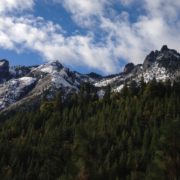New Recreational Access in Castle Crags Wilderness
July 11, 2018 — A unique alliance between a land trust, three timber companies, the climbing community and the Forest Service has resulted in protection of the beloved Castle Crags area in northern California, a rock climbing destination, wildlife habitat and important water source for California residents.
Two square miles of land adjacent to the Castle Crags State Park and Federal Wilderness purchased by the Wilderness Land Trust from Roseburg Forest Products has resulted in the transfer of more than 1,250 acres to the USDA-Forest Service for inclusion in the Shasta-Trinity National Forest. Funding for the transaction was provided by the David and Lucile Packard Foundation, along with the Access Fund Climbing Conservation Loan Program and The Conservation Alliance.
Eagles and other raptors frequently soar through the Crags, which contain world-class climbing opportunities. In the forest surrounding the Crags, almost 1,000 acres of mature timber also now stand protected. The property is located south of Dunsmuir and Mount Shasta, just off Interstate 5, from which the Crags are clearly visible. The area contains stunning views of Mount Shasta and Mount Lassen. Little Castle Creek provides spawning habitat for trout and fishing opportunities and it flows to the Sacramento River, providing clean water throughout California via the Sacramento River Delta.
“The land contains 360 acres of the Crags with dramatic rock outcrops and amazing views that are part of local history,” said Aimee Rutledge, vice president and California program manager for The Wilderness Land Trust. “The Wintu Tribe fought and died to protect it and still come for spiritual healing and guidance and to collect plants for medicinal purposes.”
Ranging from the bottom of Little Castle Creek to the top of Castle Crags, the area has few developed trails, the primary one accessing Castle Dome. Local groups like the Mount Shasta Trail Association have proposed building an Around-the-Crags Trail at some time in the future.
Other partners critical to the success of the project include local climbers and businesses. The Crags contain more than 20 challenging climbing routes as recently detailed in the Castle Crags section of “Mount Shasta Area Rock Climbing — A Climber’s Guide to Siskiyou County” by Grover Shipman.
“The acquisition is a great example of a large-scale win-win for conservation, cultural resources, and recreation, including access to incredible wilderness climbing,” says Joe Sambataro, access director for the Access Fund. “This type of deal is about protecting the outdoors and ensuring future experiences.”
“We are proud to be a part of the effort to increase the protected acreage at Castle Crags, and to improve access to this special place,” said John Sterling, executive director of The Conservation Alliance, a group of outdoor industry companies that work together to support conservation initiatives. “Our member companies benefit when outdoor recreation is more accessible.”
“Roseburg recognized there was a higher and better use for this land and was happy to make the sale. It maintains the company’s long tradition of active community support,” said Scott Folk, senior vice president of Resources at Roseburg.
The transaction culminated two years of collaboration between Roseburg and the Trust. In addition, Sierra-Pacific Industries and Kimberly-Clark Corporation assisted in the disposition of legacy mineral and access issues.




